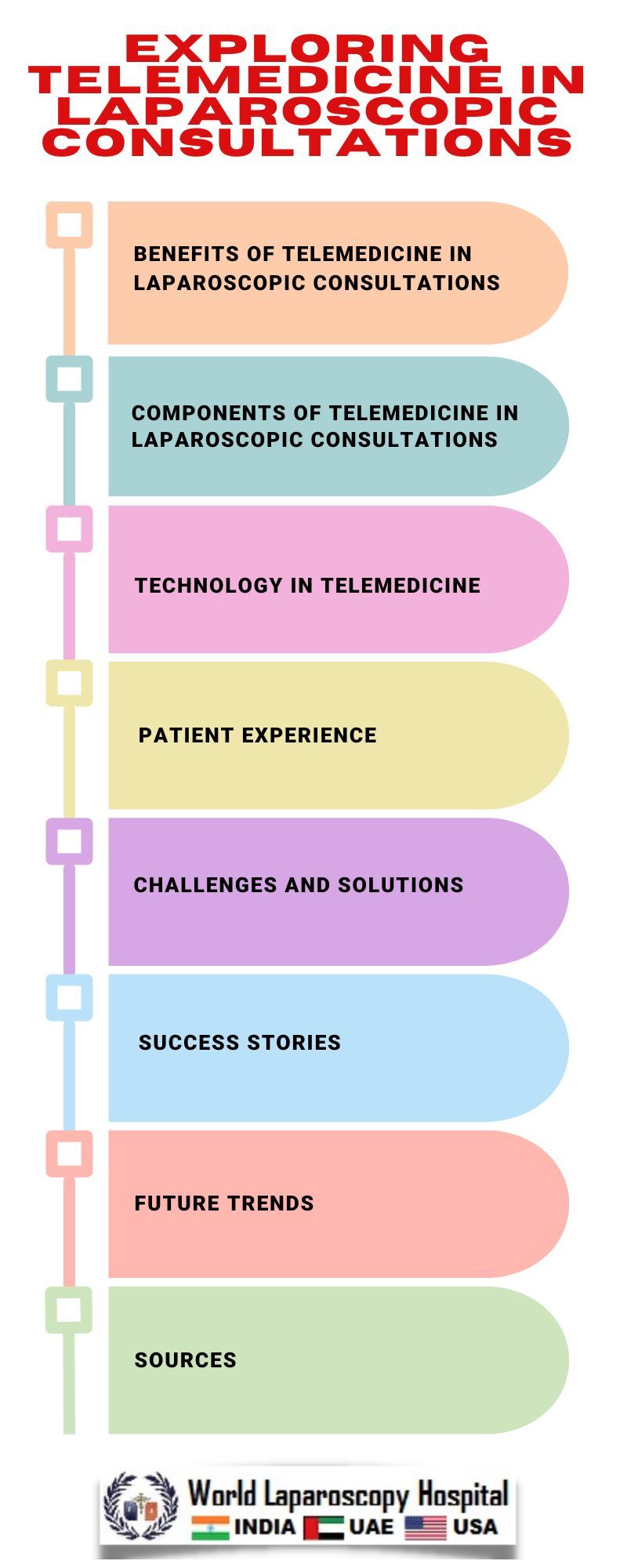Exploring Telemedicine in Laparoscopic Consultations
Introduction:
In recent years, telemedicine has emerged as a transformative force in healthcare, reshaping the way medical consultations are conducted. This paradigm shift extends to various medical specialties, including the realm of laparoscopic surgery. This article explores the evolving landscape of telemedicine in the context of laparoscopic consultations, aiming to elucidate its implications, benefits, challenges, and potential future directions.

Background of Telemedicine:
Definition and Scope:
Telemedicine refers to the use of telecommunications technology to provide healthcare services remotely. This encompasses a wide range of applications, from virtual consultations to remote monitoring and the exchange of medical information.
Evolution and Adoption:
The evolution of telemedicine can be traced back to the early experiments with telegraph-based consultations in the 19th century. However, the real surge in telemedicine adoption has occurred with the advancement of digital technologies, especially in the 21st century. The widespread availability of high-speed internet, coupled with the proliferation of smartphones and other connected devices, has catalyzed the integration of telemedicine into mainstream healthcare.
Laparoscopic Surgery: A Brief Overview:
Definition and Technique:
Laparoscopic surgery, also known as minimally invasive surgery, involves the use of small incisions and specialized instruments to perform surgical procedures. This technique offers numerous advantages over traditional open surgery, including reduced recovery times, smaller scars, and decreased postoperative pain.
Importance of Visual Feedback:
In laparoscopic surgery, visual feedback plays a crucial role in guiding the surgeon's movements. The use of a camera inserted through a small incision provides a magnified view of the surgical site on a monitor, allowing for precise and controlled maneuvers.
Telemedicine in Laparoscopic Consultations:
Remote Consultations and Preoperative Assessments:
Telemedicine facilitates remote consultations between patients and surgeons, allowing for preoperative assessments without the need for physical presence. Through video calls, surgeons can discuss medical histories, review diagnostic images, and address patient concerns, streamlining the preoperative process.
Virtual Surgical Planning:
With the aid of telemedicine, surgeons can engage in virtual surgical planning, collaboratively discussing and strategizing procedures with colleagues regardless of geographical distances. This approach fosters interdisciplinary collaboration and harnesses collective expertise for optimal patient outcomes.
Telemonitoring and Postoperative Care:
Beyond consultations, telemedicine enables remote monitoring of patients during the postoperative period. This includes virtual follow-up appointments, allowing surgeons to assess recovery progress, address complications, and provide necessary guidance without the need for in-person visits.
Benefits of Telemedicine in Laparoscopic Consultations:
Accessibility and Reach:
Telemedicine breaks down geographical barriers, ensuring that patients, regardless of their location, can access specialized laparoscopic consultations. This is particularly impactful for individuals in remote or underserved areas who may face challenges in reaching healthcare facilities.
Time and Cost Efficiency:
The virtual nature of telemedicine eliminates the need for travel, reducing the time and cost associated with in-person consultations. This is beneficial for both patients and healthcare providers, contributing to a more efficient use of resources.
Enhanced Collaboration:
Telemedicine fosters collaboration among healthcare professionals, allowing for real-time consultations and knowledge exchange. Surgeons can seek input from colleagues, share insights, and collectively contribute to refining surgical plans, ultimately enhancing the quality of care.
Challenges and Considerations:
Technological Limitations:
While advancements in technology have propelled the growth of telemedicine, challenges persist. Issues such as internet connectivity, hardware limitations, and the need for specialized training in telemedicine platforms can pose obstacles to seamless implementation.
Patient Acceptance:
Patient acceptance and comfort with virtual consultations play a pivotal role in the success of telemedicine in laparoscopic surgery. Building trust and addressing concerns regarding the effectiveness and security of remote healthcare delivery are essential considerations.
Legal and Regulatory Framework:
The legal and regulatory landscape surrounding telemedicine is dynamic and varies across regions. Ensuring compliance with regulations, addressing licensure issues, and navigating the complexities of reimbursement are ongoing challenges in the integration of telemedicine into laparoscopic consultations.
Future Directions and Innovations:
Integration of Artificial Intelligence:
The integration of artificial intelligence (AI) holds promising prospects for the future of telemedicine in laparoscopic surgery. AI-powered tools can assist in image analysis, surgical planning, and decision-making, augmenting the capabilities of healthcare professionals.
Augmented Reality and Virtual Reality:
Advancements in augmented reality (AR) and virtual reality (VR) technologies present opportunities to enhance the immersive nature of telemedicine in laparoscopic consultations. These technologies can provide surgeons with realistic, three-dimensional views of the surgical site, further improving precision and accuracy.
Continued Research and Collaboration:
Ongoing research and collaboration between healthcare professionals, technologists, and policymakers are essential for refining telemedicine applications in laparoscopic surgery. By addressing existing challenges and exploring innovative solutions, the field can continue to evolve and optimize patient care.
Conclusion:
The exploration of telemedicine in laparoscopic consultations represents a dynamic intersection of technology and healthcare. As the field continues to advance, the benefits of accessibility, efficiency, and collaboration become increasingly evident. While challenges persist, ongoing innovation, research, and a collaborative approach hold the key to unlocking the full potential of telemedicine in enhancing the quality and reach of laparoscopic surgical care.
